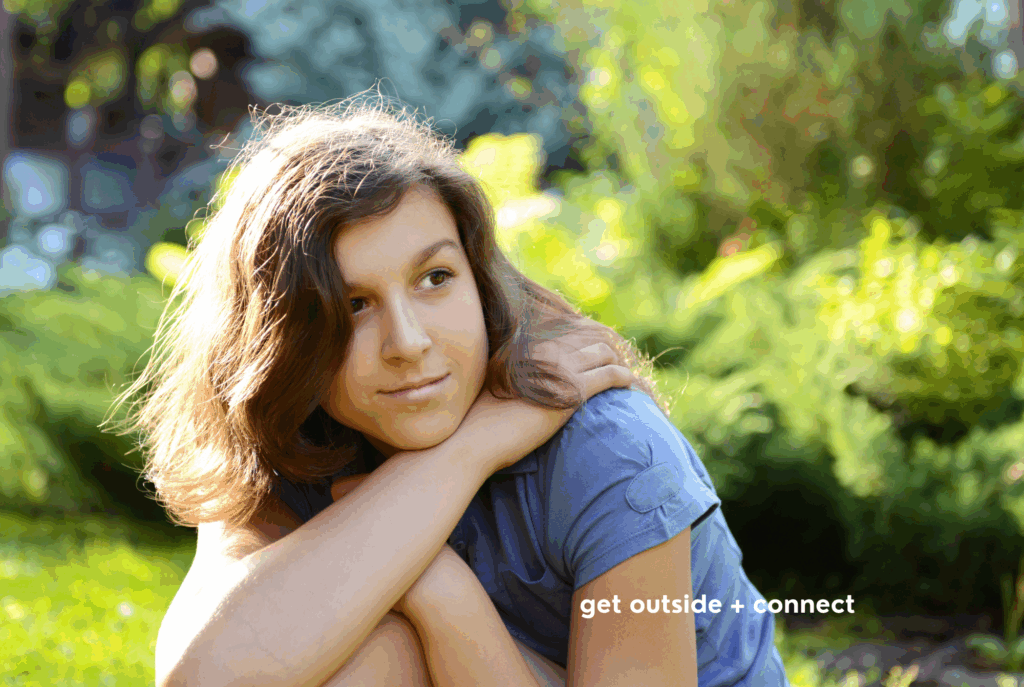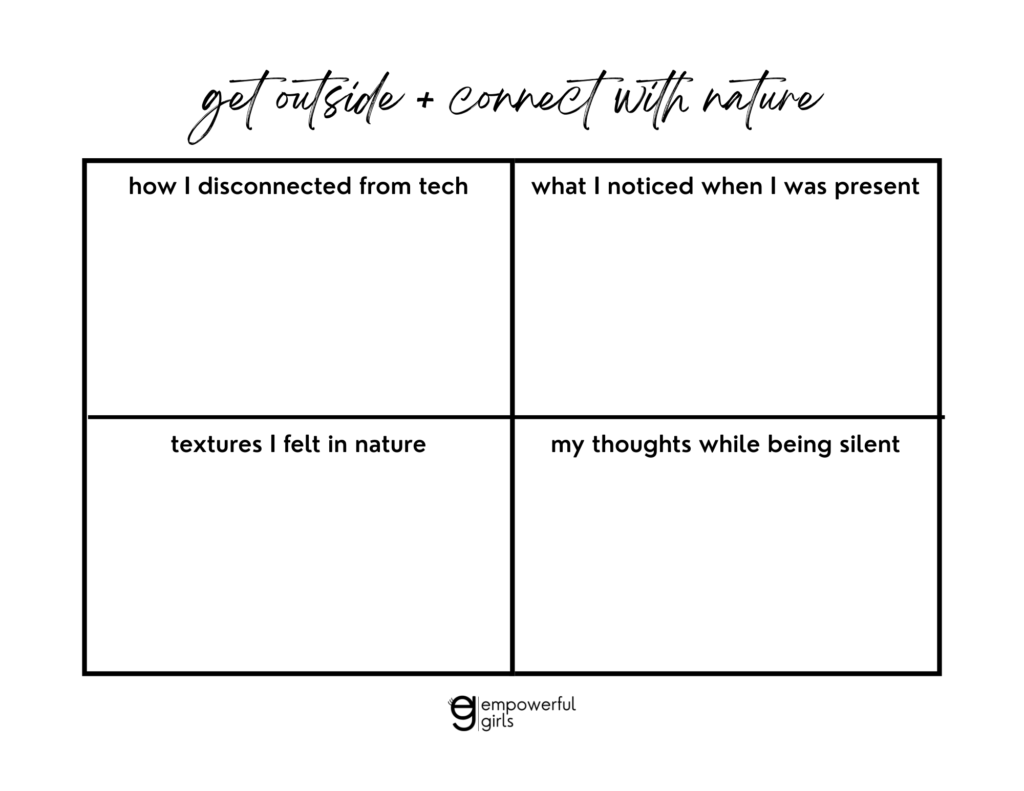
Nature is Out There
I’ve wanted to talk about this for a while. And now that the seasons are shifting and the weather is getting nicer, I want to discuss getting outside and connecting with nature. Now you might live in a city that doesn’t appear to have a lot of natural elements, or you might live in a manicured master planned community (like me). But you don’t have to live next to a forest or mountains or beach to experience nature. Wherever you’re at, there are more opportunities than you think.
But along with limited access to nature, because of our busy schedules, and more so because of social media, streaming, and gaming, people are spending less and less time outside. A survey by The Medium found that nearly one in five American adults spend less than 15 minutes a day outside. This survey did not include children or teens, but I bet you can imagine your peers aren’t doing much better than the adults.
Numerous studies have shown the benefits of getting outside, so let’s explore–literally.
Less Stress
A study published in Frontiers in Psychology showed that spending 20 minutes in nature can lower the stress hormone cortisol. Now, the study participants were instructed to avoid social media, phone calls, reading, etc. while spending time outside, and that likely improved their results. I bet you could find 20 minutes every day to spend time in nature–in your backyard, walking at a park, admiring someone’s garden … Honestly it’s so simple I’d say it’s worth trying, making a regular habit of it to see if you feel better.
More Happiness
Many studies have shown the links between nature experience and increased psychological well-being, including happiness, positive social interactions, a sense of purpose, and much more. Who doesn’t want to feel better? And if something as simple as spending time in nature can improve our overall well-being, that should be prioritized by individuals, schools, employers, communities, and governments.
Mental Health
The University of Michigan surveyed a thousand teens and young adults about nature, and more than half of them said that nature made them feel calm and more than one-fifth said it relieved stress or reduced anxiety. Also, in an article published by Mayo Clinic, nurse practitioner Jodie M. Smith said studies have shown that spending time in nature can help people cope with depression, anxiety, PTSD, and ADHD. I find this information quite significant, as mental health struggles are rising. And I’m not saying nature will cure you of a mental health condition. From my experience and understanding, there’s no single-solution for those conditions, but a combination of relief resources, including nature, can be effective for reducing symptoms.
Restoring Attention
The Journal of Environmental Psychology shared a study out of Australia where participants stared for 40 seconds at either a scene of a flowering meadow green roof or a bare concrete roof. And then they were asked to perform an attention task. Those who viewed the flowering meadow green roof made significantly fewer errors on the task, showing that viewing nature can restore attention. So in theory, if you looked at a nature scene before working on your homework or taking an exam, it could improve your ability to lock in.
Cognitive Performance
Related to that study, Psychonomic Bulletin & Review published a study where participants performed a task, and then listened to either nature sounds (birds singing, rain, ocean, crickets) or urban sounds (traffic, cafe noise, AC unit humming). Then they performed the same task again. Those who had listened to nature sounds scored better on the task than the urban sounds group, showing that listening to nature sounds can improve cognitive performance. So again, either looking at nature scenes, listening to nature sounds, or both could help you focus and do better on your schoolwork.
Green Effect
A study published in Wellbeing, Space, and Society found that the more green space (parks, trails, etc.) children had in their urban neighborhoods, the less emotional problems they experienced. Another study from Health & Place showed that people who lived in the greenest areas of England were more physically active, showing that green spaces can increase people’s physical activity and improve their overall health. This is something our city planners and parks departments should really pay attention to and start making improvements. Instead of turning undeveloped land into a parking lot, create more green spaces for people to enjoy, connect with nature, connect with each other, play and explore. Until they do, you gals can look for green spaces nearby and make intentional efforts to spend time in them.
IRL
You might be wondering if looking at nature scenes on your phone, viewing nature photos, or watching a nature documentary counts for anything. While experiencing nature in real life will give you greater results, the International Journal of Wellbeing referenced multiple studies that showed virtual nature scenes can also produce benefits–but they’re not a replacement for the real thing. You’ll get more out of actually being outdoors and in nature.
More To It
Which leads to another question, is just getting outside enough? Another survey shared by Scientific Reports and conducted in Australia found that people with a weaker connection to nature, meaning they do activities outside (sports, socializing) but nature is just in the background, these folks received less mental health benefits than those who mindfully connected with nature.
So how can you do that? Here are some ideas:
Disconnect From Tech
When you’re out in nature, as much as you can, disconnect from tech. I know you don’t want to miss a message or call from your parents, or you want to take pictures or video, or you want to listen to music on your AirPods. But for at least a few minutes, put your phone on vibrate and set it aside.
Be Present
With distractions removed, take a moment to just be present. Use your senses with your surroundings: the trees and the sound their leaves make in the breeze, the colors of flowers and their smells, the different elements and textures of the ground, the taste of ocean air, the sounds and smells of a river or waves or rain, the echoes in the mountains, the habits of animals/birds/bugs, the quiet of fresh snow or how it crunches when you step. Take it all in and be present in nature.
Touch Grass
People may be kidding when they say “touch some grass” but there is something about feeling nature on your skin. Walk barefoot on a lawn, dirt, sand, or snow. Carefully step into the chilly water of a calm stream. Place your hands in grass and feel the earth beneath it. Touch the texture of leaves or flowers (without picking them). Make a snowball and then smush it in your hands. Sift sand or dirt through your fingers. Have a tactile connection with nature.
Silence + Meditation
Spend a few minutes being silent. No distractions, no music, no podcasts, no conversations, no artificial noises. Just you and nature for a moment. Give yourself space to feel the experience, and notice what thoughts you have when you allow quiet. You can sit still while doing this or go on a meditative walk, just notice what comes up–curiosity, gratitude, wonder, parallels. The first time I did this intentionally, I was silent for an hour (episode 118). I was skeptical at first, but it was such an impactful experience that I’ve continued to make time for silence, whether it’s an hour or just a few minutes.
Nature offers numerous benefits and relief. It’s there waiting for us to experience it. The world is so noisy and it’s drowning out nature, so we need to get outside and reestablish our connection with it.
Get Outside + Connect with Nature Printable
To help you remember all of this, I made a “Get Outside + Connect with Nature” poster for you to print out, personalize, and post on your wall where you’ll see it, remember it, practice it, and believe it — that’s the important part.
Resources
If you have a topic suggestion, I’d love to hear from you! Send an email (tweens get the OK from your parents) to hello@EmpowerfulGirls.com .
If you have social media already, follow me on Insta or tiktok @empowerfulgirls. I’m not encouraging or endorsing social media, but I’m on there to offer an unfiltered, uplifting alternative to what’s in your feed. Remember to get on the email list for the newsletter!
Also, if you enjoy listening to 10 for Teens + Tweens, I would truly appreciate you telling your friends about this podcast or leaving a review so others can find it and feel uplifted, too! Your support means the world to me!
